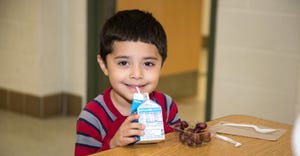Gene variant affects fiber structure of pork muscle
Korean pig breed with more slow muscle fibers has meat with deeper red color, more marbling and more flavor.
October 17, 2019

In South Korea, the unique Korean Native Black Pig is known for its red, marbled, good-tasting meat. Now, an international research team has shown that this pig breed has a gene variant that affects the fiber structure of the muscle tissue, giving the pig more slow muscle fibers, according to an announcement from the Swedish University of Agricultural Sciences (SLU).
This gene variant is not found in modern western pig breeds, SLU said.
The results were recently published in the journal PLoS Genetics by a South Korean research team, in collaboration with colleagues from France, Spain and Sweden.
Local native pig breeds have many characteristics influenced by genetic variants that have been lost in modern meat-producing pig breeds, SLU said, noting that the South Korean pig breed from the island of Jeju -- the Korean Native Black Pig -- is an example of such a breed. It is known for its red-colored and marbled meat, which has a redder color and more intramuscular fat storage compared to meat from a modern domesticated pig.
By crossing the Korean Native Black Pig with domesticated pigs and then studying the meat quality of the crosses using modern genetic and molecular genetic methods, the researchers were able to show which gene in the genome causes the marbling and the red meat color, SLU said.
"It turned out to be a gene variant in the myosin gene MYH3 that causes more of this important protein to be produced in the Jeju pig. This gene variant is not found in the common pig breeds we use in Europe for meat production," said Göran Andersson, SLU molecular genetics professor who was involved in the research.
"Myosin is an important protein for the muscle's ability to contract, and myosin of the type MYH3 affects the muscle tissue's fiber composition," Andersson explained.
The researchers showed that the Jeju pig has a gene variant that makes more MYH3 protein, which changes the muscle tissue's fiber composition into so-called slow muscle fibers, SLU said. Due to the high content of myoglobin, the color of these fibers is red, and because the fat storage acts as a fuel for the muscle cells, the marbling occurs.
According to the announcement, unlike local native breeds, the commercial swine industry has bred pigs mainly for muscle growth, and the proportion of slow muscle fibers has been reduced, which explains the underlying genetic difference among these pig breeds and the biological cause of a basic muscle trait in pigs, SLU said.
"The local native breeds around the world have many gene variants that make them well adapted to the local environment in which they live. They are, therefore, very important resources for ensuring sustainable global food production in the future, especially to meet the challenges of a changing climate. Producing sustainable meat that also tastes good is a win-win situation," Andersson concluded.
You May Also Like



